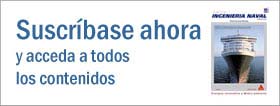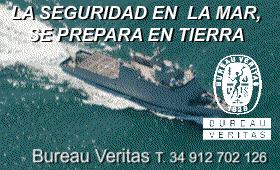1.- General Rules
1.1.- The magazineIngeniería Naval (RIN) is edited by the Spanish Association of Naval Architects and Marine Engineers, therefore the articles should be focused on the marine sector, engineering, marine sciences, techniques, economics, history or culture and they should be related to the Naval Architecture or Marine engineering.
1.2.- RIN will present the papers to its Technical Comitee to undergo a peer-review. The Comitee will decide to accept, reject or advice modifications the papers.
1.3.- The papers should be original. In case a paper is accepted, the author should not send the paper to another magazine for publication until it is published at RIN. In any case, the publication in another magazine should cite RIN.
1.4. – RIN will publish the complete article unless it is agreed otherwise with the author..
2.- Manuscript guidelines
2.1.- The papers should have a maximum of 15000 words (including the bibliography). Exceptionally, a longer article could be included if the editor and the Technical Comitee approves it. The papers can be written in Spanish or English.
2.2.- A content index should be included. Also the paper should include an abstract (150-200 words) in Spanish and English and between 5 and 6 keywords for the paper (both in Spanish and English).
2.3.- The articles should be presented in a computer file (.doc or .odt as show in the template). Templates in Spanish: .doc, .odt
2.4.- Below the title, the author/s should include their names and surnames, e-mail address, academic or professional affiliation. The authors who do not mind for the readers to contact them, should say so, and specify a contact address.
2.5.- The body of text should be written in a clear and proper way, avoiding repetitions and the use of first-person narrative. The text should be divided into sections and subsections.
2.6.- There should not be more than 20 graphics, drawings or pictures. They should have enough quality as to be printed (300 ppi). All tables and figures must be numbered and include a title; they must also designate the source at the footer.
2.7.- Bibliographical references shall be placed at the end of the article. The bibliography should be presented following the ISO 690 rules.
2.8.- The research documents should include the following information:
- Title in Spanish and English
- Authors (names and surnames, e-mail address, academic or professional affiliation)
- Name of the project or research group (if needed)
- Name and surname of the project director, doctoral thesis, etc.
- Abstract (150-200 words) in Spanish and English
- Keywords (between 4 and 6) in Spanish and English
- Body of text, divided into sections and subsections
- Bibliography
- All tables and figures must be numbered and include a title; they must also designate the source at the footer.
Languages
Full-text papers will be published in the language they were written in and approved by the evaluating committee. Languages include Spanish and English.
Bibliographical references
Bibliographical references shall be preferably presented following ISO 690 (INTERNATIONAL STANDARD ORGANIZATION. Norme internationale ISO 690: documentation – références bibliographiques – contenu, forme et structure. 2e éd. [Genève]: ISO, 1987), as shown in the following examples.
| Revista editada por la Asociación de Ingenieros Navales y Oceánicos de España. Fundada en 1929 por Áureo Fernández Ávila, I.N.
Presidente de AINE y de la comisión de la Revista : Vocales de la Comisión de la Revista : Raúl Villa Caro, Dr. I. N. Jesús Valle Cabezas, Dr. I. N. Francisco Pérez Villalonga, Dr. I. N.
Publicidad: Diseño y Maquetación: Impresión Notas: No se devuelven los originales. La Revista de Ingeniería Naval es una publicación plural, por lo que no necesariamente comparte las opiniones vertidas por sus colaboradores en los artículos y trabajos publicados, ni se identifica con ellos, y sin que esta Revista, por su publicación, se haga en ningún caso responsable de aquellas opiniones. Los firmantes de los artículos y trabajos publicados son autores independientes y los únicos responsables de sus contenidos. Se permite la reproducción de nuestros artículos indicando su procedencia. Datos Técnicos: Ingeniería Naval Académica: |



.gif)








